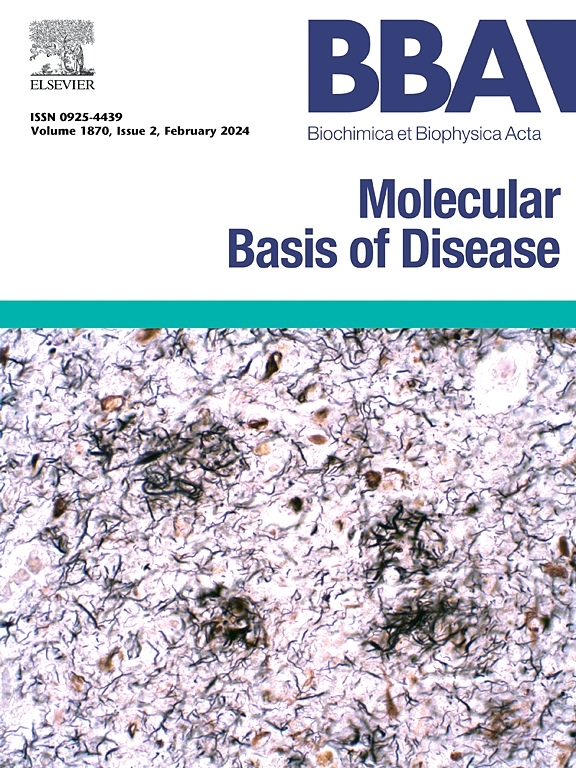ATR inhibition promotes synergistic antitumor effect in platinum-resistant pancreatic cancer
IF 4.2
2区 生物学
Q2 BIOCHEMISTRY & MOLECULAR BIOLOGY
Biochimica et biophysica acta. Molecular basis of disease
Pub Date : 2024-12-15
DOI:10.1016/j.bbadis.2024.167625
引用次数: 0
Abstract
Background
Oxaliplatin is a commonly used platinum-based chemotherapy drug for patients with pancreatic cancer (PC). Drug resistance is a major challenge in PC treatment, underscoring the urgent need for new approaches. Targeting DNA damage repair, one of the factors responsible for platinum resistance, is an attractive strategy to overcome drug resistance. This study aimed to investigate the potential of the ATR inhibitor BAY 1895344 in improving the drug responsiveness of oxaliplatin-resistant PC.
Methods
Oxaliplatin-resistant PC cells (CFPAC-1 and Capan-2) were selected and treated with oxaliplatin, BAY 1895344, or a combination of both in vivo and in vitro. Their combinatorial effects on the DNA damage response (DDR) signaling pathway, apoptosis, and extent of DNA damage were evaluated using appropriate methods. Patient response was predicted using organoid models.
Results
Combination treatment with BAY 1895344 and oxaliplatin exhibited a synergistic effect on both PC cell lines, with the effect being more pronounced on Capan-2. Additionally, the combination treatment substantially suppressed phospho-Chk1, a coordinator of DDR and cell cycle checkpoints. Mechanistically, ATR inhibition augmented the DNA damage induced by oxaliplatin, leading to mitotic catastrophe and cell death. Furthermore, in an in vivo study using a tumor-bearing xenograft mouse model, the combination treatment markedly reduced tumor growth. This synergistic effect was confirmed in patient-derived organoids with poor response to oxaliplatin.
Conclusion
ATR inhibition enhanced the anticancer effect of oxaliplatin, suggesting that this combination treatment could be an effective therapeutic strategy for overcoming platinum resistance in PC.

ATR抑制促进铂耐药胰腺癌的协同抗肿瘤作用。
背景:奥沙利铂是胰腺癌(PC)患者常用的铂基化疗药物。耐药是前列腺癌治疗的主要挑战,因此迫切需要新的治疗方法。靶向DNA损伤修复是导致铂耐药的因素之一,是克服耐药性的一种有吸引力的策略。本研究旨在探讨ATR抑制剂BAY 1895344在改善奥沙利铂耐药PC的药物反应性方面的潜力。方法:选择奥沙利铂耐药PC细胞(CFPAC-1和Capan-2),在体内和体外分别用奥沙利铂、BAY 1895344或两者联合治疗。采用适当的方法评估它们对DNA损伤反应(DDR)信号通路、细胞凋亡和DNA损伤程度的组合影响。使用类器官模型预测患者反应。结果:BAY 1895344联合奥沙利铂对两种PC细胞系均有协同作用,且对Capan-2的作用更为明显。此外,联合治疗显著抑制phospho-Chk1, DDR和细胞周期检查点的协调者。从机制上讲,ATR抑制增强了奥沙利铂诱导的DNA损伤,导致有丝分裂灾难和细胞死亡。此外,在一项使用荷瘤异种移植小鼠模型的体内研究中,联合治疗显着降低了肿瘤生长。这种协同效应在对奥沙利铂反应较差的患者源性类器官中得到证实。结论:ATR抑制可增强奥沙利铂的抗癌作用,提示该联合治疗可能是克服PC铂耐药的有效治疗策略。
本文章由计算机程序翻译,如有差异,请以英文原文为准。
求助全文
约1分钟内获得全文
求助全文
来源期刊
CiteScore
12.30
自引率
0.00%
发文量
218
审稿时长
32 days
期刊介绍:
BBA Molecular Basis of Disease addresses the biochemistry and molecular genetics of disease processes and models of human disease. This journal covers aspects of aging, cancer, metabolic-, neurological-, and immunological-based disease. Manuscripts focused on using animal models to elucidate biochemical and mechanistic insight in each of these conditions, are particularly encouraged. Manuscripts should emphasize the underlying mechanisms of disease pathways and provide novel contributions to the understanding and/or treatment of these disorders. Highly descriptive and method development submissions may be declined without full review. The submission of uninvited reviews to BBA - Molecular Basis of Disease is strongly discouraged, and any such uninvited review should be accompanied by a coverletter outlining the compelling reasons why the review should be considered.

 求助内容:
求助内容: 应助结果提醒方式:
应助结果提醒方式:


